CALANGUTE BEACH
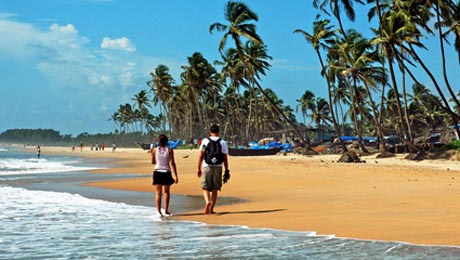
Calangute is a town in North Goa, famous for its beach. The beach is the largest in North Goa and visited by thousands of domestic and international tourists alike. The peak tourist season is during Christmas and New Year, and during the summer in May. During the monsoon season, from June through September, the sea can be rough and swimming is prohibited. The beach offers water sport activities like parasailing and water skiing, among others.
VAGATOR BEACH
Vagator Beach has dramatic red cliffs looking down on the shore and two fresh water springs within a stone's throw of the sea. But Vagator has little by way of seaside accommodation. Vagator Beach is split into two main beaches by a seaside headland which holds the car park and lots of stalls selling trinkets, clothes, soft drinks and snacks. As you face the sea, on your right is North Vagator Beach and on your left Ozran Beach, more commonly known as Little Vagator Beach. Vagator is a little more laid back, though still pretty much steeped in the rave culture. The tourist traffic is predominantly Western backpackers, however it has also become popular with Indian tourists, who particularly come to watch the sunset from the rocks.
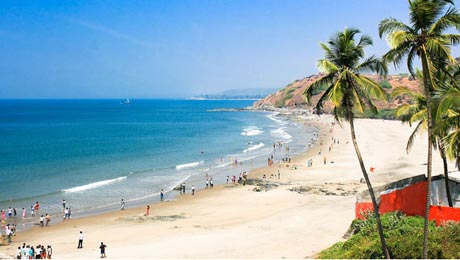
BAGA BEACH
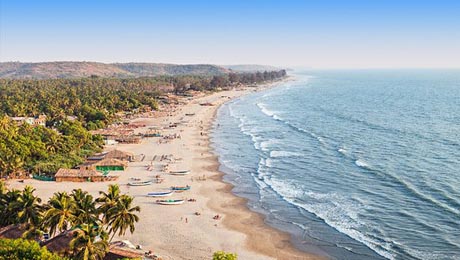
Baga Beach is a popular beach and tourist destination in North Goa.[1][2] Baga is located at the north end of the contiguous beach stretch that starts from Sinquerim, Candolim, leads to Calangute and then to Baga. The beach contains rows of shacks and fishing boats, and at high tide the beach is narrow. The beach is named after the Baga Creek, which empties into the Arabian Sea at the north end of the beach. Baga Beach is also famous for water sports such as parasailing and banana rides, and dolphin cruises. In Baga Beach, new parking has been constructed for around 800 cars or more, and there is baga creek bridge which connects northern part like arpora, anjuna etc..
ARPORA NIGHT MARKET
The night market in Arpora, also known as The Saturday Night Market or Ingos Saturday Nite Bazaar is the largest shopping and entertainment event, which reflects the cosmopolitan and distinctive culture of Goa state in the best way. As you can see from the name, the market takes place on Saturdays. This event happens only during the high tourist season on a large fenced area between the Arpora and Anjuna city resorts. The first season night market is usually arranged before the New Year, while the last one is organized at the end of April ( the business hours: from 4:00 p.m till 11:00 p.m). The Saturday Night Market in Arpora is a must for sightseeing which every tourist should visit while traveling toGoa. On Saturday evenings the entertainment spots are usually empty because the tourists are flocking to the market.
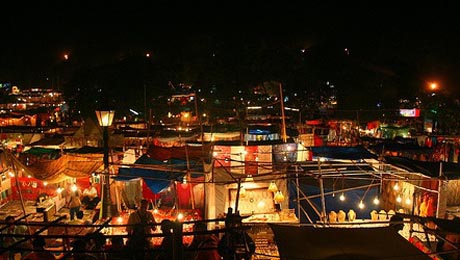
AGUADA FORT
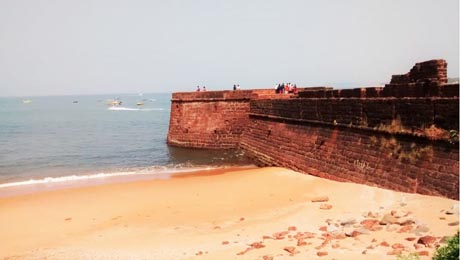
A freshwater spring within the fort provided water supply to the ships that used to stop by. This is how the fort got its name: Aguada, meaning Water. Crews of passing ships would often visit to replenish their fresh water stores. On the fort stands a four-storey Portuguese lighthouse, erected in 1864 and the oldest of its kind in Asia. Built in 1612, it was once the grandstand of 79 cannons. It has the capacity of storing 2,376,000 gallons of water, one of the biggest freshwater storages of the time in whole of Asia. This fort is divided in two segments: the upper part acted as fort and watering station, while the lower part served as a safe berth for Portuguese ships. Fort Aguada was the most prized and crucial fort of Portuguese. The fort is so large that it envelops the entire peninsula at the south western tip of Bardez.
OUR LADY OF THE IMMACULATE CHURCH
The Our Lady of the Immaculate Conception Church is located in Panjim, Goa, India. The Church conducts mass every day in English, Konkani, and Portuguese. This church houses the ancient bell that was removed from the Augustinian ruins of the Church of Our Lady of Grace in the once famed city of Old Goa. This bell is considered to be the second largest of its kind in Goa, surpassed only by the Golden Bell which resides in the Sé Cathedral in Old Goa. The second largest church bell in Goa was installed in a bell tower in 1871. It was formerly at the Augustinian Monastery on Holy Hill, and was retrieved after the monastery was damaged.

REIS MOGOS FORT
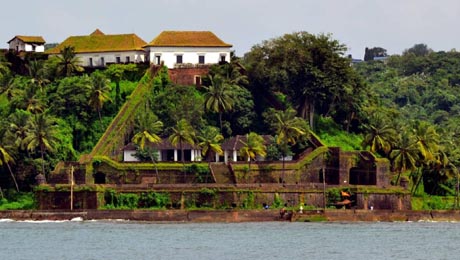
Reis Magos is a village located on the northern bank of the Mandovi River in Bardez, Goa, opposite to the capital city of Panjim. The village is famous for two of Goa’s famous structures; the Reis Magos Fort, and the Reis Magos Church – the first church in Bardez. Reis Magos is the Portuguese name for the Three Wise Men from the Bible. This Fort, surrounded by sturdy laterite walls studded with typically Portuguese turrets, was erected in 1551 to protect the narrowest point at the mouth of the Mandovi estuary. It was enlarged subsequently on different occasions and finally re-erected in 1707. The fort formerly accommodated viceroys and other dignitaries newly arrived from, or en route to, Lisbon, and in the early eighteenth century proved a linchpin in the wars against the Hindu Marathas, who were never able to take it.

